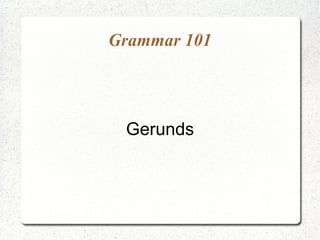
LL Lower Pri D - Gerunds
- 2. Learning Objectives To understand what Gerunds are and to avoid the mistake of interpretating them as verbs. To learn how to use Gerund in a sentence so as to enhance its meaning.
- 3. Introduction Read the following sentences and say whether they are grammatical or not. 1) “She is practising speaking English for her exams next week.” 2) “I wonder at his keeping calm.” 3) “All I can do is waiting.” Q: Do you think these are grammatical sentences? Hint: They all contain gerunds.
- 4. Introduction The answer for all is a resounding 'Yes!' Some facts about Gerunds: 1) They look like verbs with the 'ing' participle. 2) Hence, they are also called verbal nouns. 3) They can either be the subject or object in a sentence. 4) They enhance the meaning of your sentences. We will discuss these in detail.
- 5. Gerunds = Verbal Nouns Gerund ends with 'ing' and can act as a sentence's subject or object. Hence, gerund is often called a Verbal Noun as it has the form of a verb but functions as a noun. Gerunds as Subjects: 1) Swimming helps me to keep fit. 2) Reading expands one's horizons. Gerunds as Objects: 1) Peter loves jogging. 2) Dave loves watching movies.
- 6. Gerunds and Verbs Since a gerund looks like a verb, it is sometimes confusing telling the two apart. To overcome this, determine whether the 'ing' participle is a modifier to an action (verb) or a subject/object (gerund) Gerunds: Swimming is fun. / I love swimming. Verbs: She is swimming in a public pool. / He was swimming when the skies turned dark. As easily seen, gerunds act as subjects/objects while verbs convey actions (supported by auxiliary verbs 'is' and 'was' in the above examples).
- 7. Gerunds in action With a gerund, the subject/object takes on greater emphasis; the 'action' behind the noun is clearer. 1) David accused James of stealing. (gerund) 2) David accused James of theft. (noun) 1) It's no use regretting past actions. (gerund) 2) It's no use to regret past actions. (verb) The difference between using a Gerund ('stealing / regretting') and a Noun ('theft') or a Verb ('to regret') is clear – Gerunds can help readers imagine better as it acts as a Verb AND a Noun!
- 8. Learning Activity Spot the Gerunds in this paragraph: 'Readers of science fiction expect to be exposed to a world different than our own. However, certain physical rules and laws still apply in daily living and working life for a sense of credibility and coherence.'
- 9. Learning Activity Answers Spot the Gerunds in this paragraph: 'Readers of science fiction expect to be exposed to a world different than our own. However, certain physical rules and laws still apply in daily living and working life for a sense of credibility and coherence.' The Gerunds are 'living' and 'working'.
- 10. Discussion 1) What is a Gerund? 2) What are Gerunds used for?
- 11. In Summary 1) Gerunds are verbal nouns and they are able to take on roles as subjects or objects in a sentence. 2) As they have the 'ing' suffix – indicating action – they are able communicate the action behind the noun to enliven our sentences.
